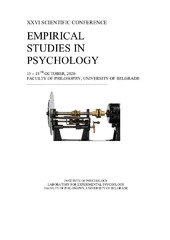| dc.description.abstract | The vast majority of studies investigating personality structure is done using adult samples. If
personality is assessed in children, parental ratings are preferably used method, while self reports are seldom used. Here we use self-report measures to study the developmental
stability of the seven-factor personality structure defined by the HEXACO model and
Disintegration trait. We focus on middle childhood children, young teens, and teenagers.
Sample consisted of four groups: 1) age 10-11 (N=164, 49.4% female), 2) age 12-13 (N=195,
48.9% female), 3) age 14-16 (N=319, 59.2% female), 4) age 17-18 (N=201, 49.5% female).
Data were collected in several elementary and high schools in Serbia and Montenegro.
Personality traits were assessed using 60 items HEXACO, and 20 items DELTA
questionnaires. The stability of the seven-factor personality structure was tested using
orthogonal procrustes rotations, and the analysis was done on facets of all seven personality
traits. Congruence coefficients and factor loadings were calculated for all facets for all six
pairwise comparisons. Overall, the average congruence of factors ranged between .69
(Emotionality) and .96 (Disintegration). The average congruence of facets ranged between
.41 (Sincerity) and .95 (Sentimentality), with the majority of facets having average
congruence above .85. Average factor loadings for Disintegration range between .55 (Depression) and .85 (Perceptual Distortions), for Honesty between .20 (Sincerity) and .39
(Greed avoidance), for Emotionality between .19 (Anxiety) and .53 (Sentimentality), for
Extraversion between .34 (Sociability), and .47 (Social self-esteem and Liveliness), for
Agreeableness .34 (Patience), and .54 (Flexibility), for Conscientiousness .33 (Organization)
and .53 (Diligence), and for Openness .53 (Creativity) and .67 (Inquisitiveness). As expected,
personality structure is least stable in the first age group but stabilizes in groups 3 and 4. We
discuss, in detail, stability and content of personality factors on different age groups, and
practical implications on assessment these results have. | sr |

